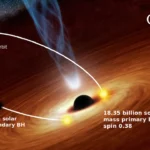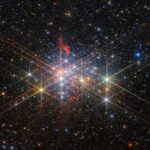Scientists at the Leibniz Institute for Astrophysics Potsdam (AIP) have uncovered the intricate magnetic heartbeat of a distant star remarkably similar to our own sun—but much younger and more active.
phys.org21- Page
An international team of astronomers has used the Atacama Large Millimeter/submillimeter Array (ALMA) to observe a well-known quasar known as the Cloverleaf. As part of the observations, they serendipitously discovered
Europe must quickly get its own reusable rocket launcher to catch up to billionaire Elon Musk’s dominant SpaceX, European Space Agency director Josef Aschbacher told AFP in an interview.
When Ann Walter looked outside her rural West Texas home, she didn’t know what to make of the bulky object slowly drifting across the sky.
SpaceX is set to finish up its third of three contracted launches of competitor Amazon’s Project Kuiper satellites on Thursday night.
Dark matter is an enigmatic form of matter not expected to emit light, yet it is essential to understanding how the rich tapestry of stars and galaxies we see in
What if our understanding of Uranus and Neptune’s compositions have been wrong, specifically regarding their classifications as “ice giants?” This is what a recent study accepted for publication in Astronomy
Smarter decisions about real-world problems start with better data—and Earth observation can provide just that, thanks to European efforts to open up access to massive amounts of satellite data collected
A discovery of binary stars could be the first step in building a more complete picture of how our galaxy formed, according to astronomers from The Australian National University (ANU).
By fitting its sunshield and solar panels, engineers have completed the construction of Plato, the European Space Agency’s mission to discover Earth-like exoplanets. Plato is on track for the final
-
 01From Polymerization-Enabled Folding and Assembly to Chemical Evolution: Key Processes for Emergence of Functional Polymers in the Origin of Life
01From Polymerization-Enabled Folding and Assembly to Chemical Evolution: Key Processes for Emergence of Functional Polymers in the Origin of Life -
 02Panasonic Leica Summilux DG 15mm f/1.7 ASPH review
02Panasonic Leica Summilux DG 15mm f/1.7 ASPH review -
 03How New NASA, India Earth Satellite NISAR Will See Earth
03How New NASA, India Earth Satellite NISAR Will See Earth -
 04And Thus Begins A New Year For Life On Earth
04And Thus Begins A New Year For Life On Earth -
 05Astronomy Activation Ambassadors: A New Era
05Astronomy Activation Ambassadors: A New Era -
06SpaceX launch surge helps set new global launch record in 2024
-
 07Two Black Holes Observed Circling Each Other for the First Time
07Two Black Holes Observed Circling Each Other for the First Time





